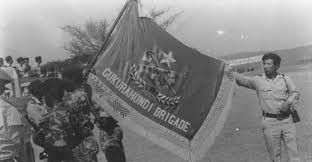
I chronicle my political analysis in my capacity as a former Zpra freedom fighter (F2, Northern Front 2, regional zone commander) who during the liberation struggle had made many promises to the peasants in the operation areas that when Zimbabwe attained its independence they would live a pretty life.
Today these promises are proving to be a pack of lies.
What happened soon after independence in 1980 to date is completely opposite to their expectations and reasons for their supporting the liberation struggle.
It is as if the peasants and freedom fighters were fighting to liberate a country for them to suffer from and not to enjoy what they fought for against British colonial rule.
It has been 43 years now since Zimbabwe attained its independence, but former Zpra and Zanla freedom fighters are still living in extreme poverty while the government they put in power remains silent about uplifting their living standards through payment of monthly pensions that are above the poverty datum line.
I assume all this is happening because the majority of people in government were at school abroad while children of the peasants were busy fighting against the Rhodesian regime forces.
They lose nothing when they see a war veteran suffer because to them it’s good as long as they remain in office to politically divide and rule war veterans for their own benefits.
I would like to remind those in government offices that what they are doing in Parliament is not what freedom fighters and peasants sacrificed their lives for.
- Chamisa under fire over US$120K donation
- Mavhunga puts DeMbare into Chibuku quarterfinals
- Pension funds bet on Cabora Bassa oilfields
- Councils defy govt fire tender directive
Keep Reading
As citizens, we are tired of personal enrichment type of politics that is meant to divide and rule people of Zimbabwe on tribal lines, false promises during elections and unfair land resettlement distribution, and unfair awarding of mining claims by government.
One company is being allowed to own all Matabeleland mining claims in a clear sign that we fought for individuals to enrich themselves at the expense of the nation.
On the rights of the veterans of the liberation struggle, the government must uphold the constitution of Zimbabwe paragraph 84,(a)(b)(c) page 39.
It says veterans of the liberation struggle are entitled to due recognition for their contribution to the liberation of Zimbabwe, and to suitable welfare such as pension and access to health care, etc.
It should be the role of the government to see that the welfare of war veterans is guaranteed and not to be pushed by veterans through demonstrations.
We are no longer able to stage demonstrations as great grand fathers and mothers.
I also urge all those officials to assist the government to run Zimbabwe on a non-partisan basis
We are all Zimbabweans and we entitled to benefit from our resources as read in paragraph 67, section (1)(a)(b) page32 (2) (a) (b) (c) (d) (3) (a) (b) page33 of the constitution.
They must also take into account property rights as according to paragraph 71 section (2) subsection 72 every person has the right in any part of Zimbabwe, to acquire, hold, occupy, use, transfer, hypothecate, lease or dispose of all forms of property, either individually or in association with others.
A good example of property rights violations is the handling of Zpra properties (Nitram Holding p/L) owned by Zpra veterans which the government confiscated in 1980s.
The properties remain in possession of the state to date.
I, therefore, in my personal capacity as someone who contributed towards the purchase of the Zpra veterans properties, I call upon the government to unconditionally remove the caveat that was put on our properties.
The properties must be returned to their rightful owners who are Zpra veterans so that they can make a decent living with their dependants and disabled colleagues, who are wallowing in poverty that is destroying the country.
Finally, I call upon the government to respect the constitution of Zimbabwe Amendment (No.20)ACT2013 and do away with any form of oppression be it economic or political.
Citizens must not be abused before, during after the elections. - *Andrew Ndlovu is a war veteran whose wartime name was Volunteer Mkhwananzi (NF2 regional zone commander.)
Embracing technology in environmental conservation efforts
M
ining remains a key sector in Zimbabwe’s economy as it is the top income earner for many Zimbabweans with over half a million people directly employed in the sector and more than a million employed along the industry’s value chain.
However, with mineral extraction comes challenges that include environmental degradation with little or no effort to rehabilitate mined areas.
Although the majority of the impacts of mining are said to be “localised”, mining can cause national, transboundary and global environmental problems.
Different mining activities employed during mining and mineral processing activities have different environmental impacts.
These activities include blasting and excavation, loading and hauling of the run of mine materials, beneficiation and waste disposal.
It is the responsibility of everyone to ensure the environment is protected and remains habitable for future generations.
The future of natural resource conservation relies on the ability to use the fourth industrial revolution technology to analyse the spatial impact of development activities and have a conclusive analysis of the cost-benefit analysis of every activity as well as modelling of possible outcomes of different intervening activities to reduce and mitigate their negative impacts.
Environmental damage by mining activities is inevitable, thus the goal is to minimise the impacts.
The Zimbabwe Environmental Law Association (Zela) is embracing the geographical information system (GIS) and remote sensing to acquire knowledge and data about mining activities and their impact on the environment.
Recently the organisation carried out a training of community monitors from different protected areas in Zimbabwe which are threatened by mining activities.
The training programme was meant to capacitate community monitors on how to employ existing and emerging GIS and remote sensing technology to monitor and map mining activities in protected areas.
GIS and remote sensing technology strengthen oversight and monitoring capacity in the mining sector, thus improving data collection and the general understanding of mining activities and their environmental impacts.
GIS and remote sensing technology enables time series analysis on the mining environmental impact assessment; thus it can be utilised by the extractive industry personnel in promoting sustainable development
If properly used GIS technology can be a critical tool in the current environmental conservation effort.
The system can be customised to fit the required purpose and produce customisable solutions for surface and subsurface investigation and analysis.
It is from the understanding that oftentimes, environmental catastrophes are a result of the inability to view the overall picture and the interlinkages between mining processes and some of the negative impacts of mining activities and plan accordingly that Zela is embracing the use of GIS for its modelling and network analysis functionality to solve this problem, reducing the amount of guesswork involved in visualising the impacts of mining activities on the environment.
The system enables a better evaluation of data using cartographic tools to display information stored in a database.
With its capabilities for spatial analysis, GIS can reveal hidden patterns and relationships between data that is not readily apparent.
The system can also perform complex regional sensitivity analysis geographically identifying areas which are either sensitive to impacts (negative mapping) or resilient (positive mapping).
It can provide a more holistic view of the impacts of any development project, on the environment mining included, improving knowledge and overview of information related to the projects’ activities and their impact on the environment.
Impacts of mining activities on the environment can be complicated in such a way that they can be either primary/secondary, short/long duration, immediate/future, reversible/ irreversible onsite/offsite or cumulative in nature and trying to assess the extent of these impacts is a complicated process which requires big data systems like GIS to do the automated analysis.
Once a potential impact has been identified, an evaluation of its likelihood, potential severity or magnitude and possible duration is needed.
GIS using its ability to link graphics with attributes data, enhanced data sharing, and modelling capabilities can easily do automated analysis and produce various visual products like maps, graphs and reports which can then be used to easily identify possible impacts of the projects as compared to various alternatives hence assist stakeholders in the mining sector make more informed decisions.
The outcomes of the planned mapping activities are expected to result in improved institutional knowledge of the impact of mining activities in protected areas as well as improve the mining sector stakeholders’ capacities to protect the environment from adverse impact of mining activities across the country. - Zimbabwe Environment Lawyers Association
ONLINE FEEDBACKDespite positive developments in media freedom and the right to free expression in Zimbabwe, the government seems to take two steps forward and five backward in fostering the enjoyment of these rights. Some positive developments in the sector include the repeal of the infamous Access to Information and Protection of Privacy Act in 2020 through the enactment of the progressive Freedom of Information Act.
The move by the government to update the media through post-cabinet briefings is welcome as it increases access to information for the people of Zimbabwe.
In addition, the government licensed community radio stations for the first time in the country’s more than four-decade post-independence existence.
However, moves by the government to introduce the highly discredited Private Voluntary Organisations (PVO) Amendment Bill, which is seen as targeting dissenting voices in civil society; the amendment of the Criminal Law (Codification and Reform) Act to criminalise the engagement of embassies by locals without government approval; the enactment of the Cyber and Data Protection Act in addition to the repressive architecture of laws such as the Censorship Entertainment and Controls Act; the Interception of Communications Act; ZBC Commercialisation Act and the Broadcasting Services Act, among others, dent the country’s global standing, and worse off during elections.
This is the season when the safety and security of journalists and media workers is an issue of grave concern. In the last general election in 2018, a total of 32 journalists, including local and international journalists, were at the receiving end of the attacks, assaults, harassment, and detentions.
Further, Zimbabwe has been one of the countries that fell into the hall of shame of being among the countries that shut down the internet. In 2016, the administration throttled the net during protests and shut down access to the platform for a week.
In 2019 in the face of national protests, it took Misa, in partnership with the Zimbabwe Lawyers for Human Rights, to end the week of internet shutdown darkness by challenging the government’s actions at the High Court. - Tabani Moyo (Misa Zimbabwe)









